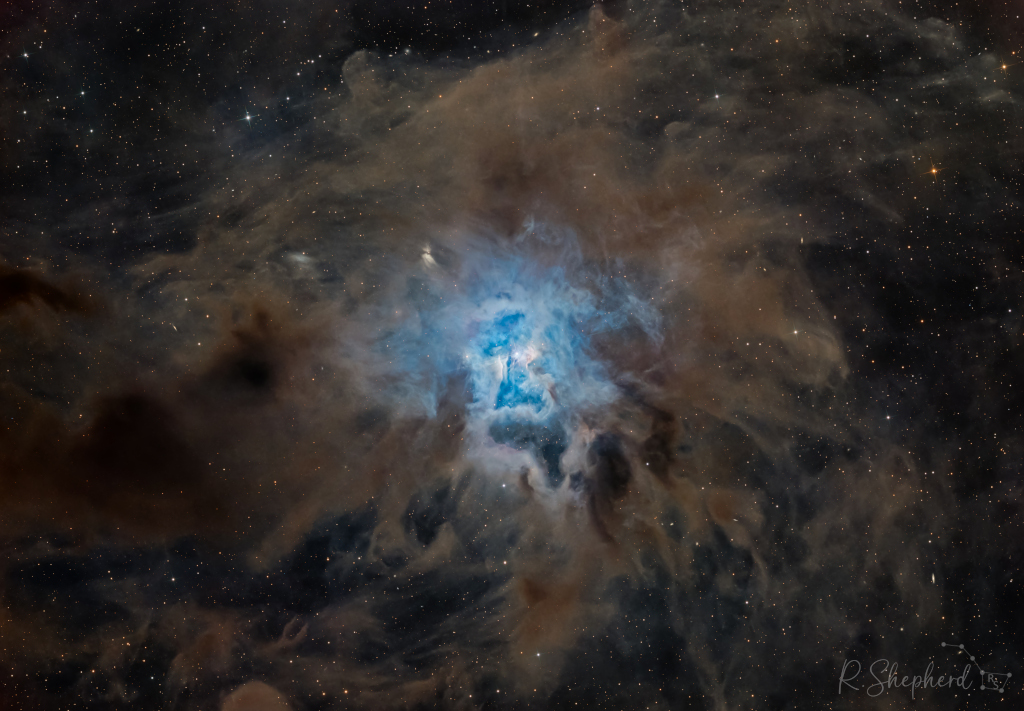Nombre total de pages vues
25/07/2024
SANTé/MEDECINE - Louis Pasteur - père de la vaccination
INVENTIONS DE DEMAIN - Ressentez la peur du héros
ASTRONOMY - NGC 7023: The Iris Nebula
Image Credit & Copyright: Robert Shepherd
Explanation: These cosmic clouds have blossomed 1,300 light-years away in the fertile starfields of the constellation Cepheus. Called the Iris Nebula, NGC 7023 is not the only nebula to evoke the imagery of flowers. Still, this deep telescopic image shows off the Iris Nebula's range of colors and symmetries embedded in surrounding fields of interstellar dust. Within the Iris itself, dusty nebular material surrounds a hot, young star. The dominant color of the brighter reflection nebula is blue, characteristic of dust grains reflecting starlight. Central filaments of the reflection nebula glow with a faint reddish photoluminescence as some dust grains effectively convert the star's invisible ultraviolet radiation to visible red light. Infrared observations indicate that this nebula contains complex carbon molecules known as PAHs. The dusty blue petals of the Iris Nebula span about six light-years.
24/07/2024
ASTRONOMY - Exaggerated Moon
Credit: Data: NASA, Lunar Orbiter Laser Altimeter; Image & Processing: Ildar Ibatullin
Explanation: Our Moon doesn't really have craters this big. Earth's Moon, Luna, also doesn't naturally show this spikey texture, and its colors are more subtle. But this digital creation is based on reality. The featured image is a digital composite of a good Moon image and surface height data taken from NASA's Lunar Orbiter Laser Altimeter (LOLA) mission -- and then exaggerated for educational understanding. The digital enhancements, for example, accentuate lunar highlands and show more clearly craters that illustrate the tremendous bombardment our Moon has been through during its 4.6-billion-year history. The dark areas, called maria, have fewer craters and were once seas of molten lava. Additionally, the image colors, although based on the moon's real composition, are changed and exaggerated. Here, a blue hue indicates a region that is iron rich, while orange indicates a slight excess of aluminum. Although the Moon has shown the same side to the Earth for billions of years, modern technology is allowing humanity to learn much more about it -- and how it affects the Earth.
23/07/2024
SANTé/MEDECINE - Alexander Fleming - découvreur de la pénicilline
ASTRONOMY - The Crab Nebula from visible to X-Ray
2024 July 23
Image Credit: NASA, ESA, ASI, Hubble, Chandra, IXPE
Explanation: What powers the Crab Nebula? A city-sized magnetized neutron star spinning around 30 times a second. Known as the Crab Pulsar, it is the bright spot in the center of the gaseous swirl at the nebula's core. About 10 light-years across, the spectacular picture of the Crab Nebula (M1) frames a swirling central disk and complex filaments of surrounding and expanding glowing gas. The picture combines visible light from the Hubble Space Telescope in red and blue with X-ray light from the Chandra X-ray Observatory shown in white, and diffuse X-ray emission detected by Imaging X-ray Polarimetry Explorer (IXPE) in diffuse purple. The central pulsar powers the Crab Nebula's emission and expansion by slightly slowing its spin rate, which drives out a wind of energetic electrons. The featured image released today, the 25th Anniversary of the launch of NASA's flagship-class X-ray Observatory: Chandra.
22/07/2024
INVENTIONS DE DEMAIN - Rouler...Puis s'envoler
ASTRONOMY - Chamaeleon Dark Nebulas
2024 July 22
Image Credit & Copyright: Chang Lee
Explanation: Sometimes the dark dust of interstellar space has an angular elegance. Such is the case toward the far-south constellation of Chamaeleon. Normally too faint to see, dark dust is best known for blocking visible light from stars and galaxies behind it. In this 36.6-hour exposure, however, the dust is seen mostly in light of its own, with its strong red and near-infrared colors creating a brown hue. Contrastingly blue, the bright star Beta Chamaeleontis is visible on the upper right, with the dust that surrounds it preferentially reflecting blue light from its primarily blue-white color. All of the pictured stars and dust occur in our own Milky Way Galaxy with one notable exception: the white spot just below Beta Chamaeleontis is the galaxy IC 3104 which lies far in the distance. Interstellar dust is mostly created in the cool atmospheres of giant stars and dispersed into space by stellar light, stellar winds, and stellar explosions such as supernovas.
SANTé/MEDECINE - Karl Landsteiner : découvreur des groupes sanguins
21/07/2024
INVENTIONS DE DEMAIN - Twitter par la pensée
ASTRONOMY - Andromeda and Friends
2025 November 15 Andromeda and Friends Image Credit & Copyright : Piotr Czerski Explanation: This magnificent extragalactic skyscap...

-
2022 September 26 All the Water on Planet Earth Illustration Credit: Jack Cook, Adam Nieman, Woods Hole Oceanographic Institution ; Data ...
-
2025 May 11 The Surface of Venus from Venera 14 Image Credit: Soviet Planetary Exploration Program , Venera 14 ; Processing & Copyri...









